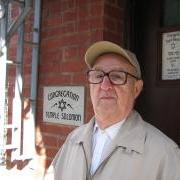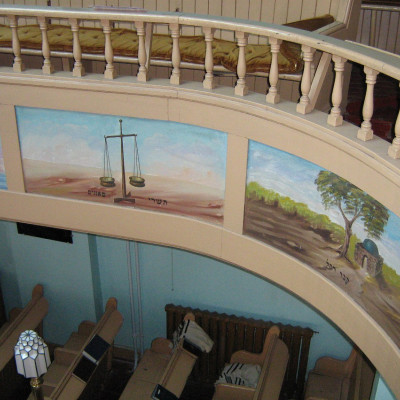A cornerstone of Montreal’s immigrant heritage stands at the corner of Bagg and Clark streets in Montreal’s now-trendy Plateau district.
Congregation Temple Solomon, or the Bagg Shul as it is more commonly known, is Quebec’s oldest original synagogue, “the only one left of its kind,” notes Joe Brick, an officer of the synagogue for nearly forty years who is leading efforts to preserve the building as living historic landmark—against all odds. More than six decades since his own bar mitzvah was held here, Brick, who has lived his whole life just a few doors down the street, remains determined to keep the ‘shul’ open, although there are fewer and fewer Jews living in the old neighbourhood. Originally a duplex, the building dates from the 1800s, and was converted to a synagogue in 1921. in Today, in a neighbourhood whose narrow, picturesque streets were once peppered with synagogues, the Bagg Shul stands alone.
 “It is special,” says Brick “because it is a replica of the old eastern European synagogues from Poland, Ukraine and other places which were all destroyed in the Second World War.”
“It is special,” says Brick “because it is a replica of the old eastern European synagogues from Poland, Ukraine and other places which were all destroyed in the Second World War.”
Thanks in large part to Brick and fellow congregants, the Bagg Shul has largely withstood the forces of time and the pressures of gentrification and change that have swept through the Plateau district over the last 30 years. In 1998, he helped lead a campaign to have the synagogue declared a religious heritage site. The designation enabled the synagogue to secure a grant for $230,000 from the Quebec government, which was spent on crucial exterior and interior renovations. The roof and windows were replaced along with the building’s crumbling brick exterior, and the dank basement was turned into a bright, serviceable space now used for Sabbath and holiday receptions.
 The grant came from the Quebec Religious Heritage Foundation, a funding program established by the Ministry of Culture and Communications in 1995. The Bagg Shul was the first synagogue to benefit from the program. At the time of its heritage designation, Quebec’s culture minister Louise Beaudoin described the shul as “a reminder of a longstanding tradition and a past with which not many Quebecers are familiar.”
The grant came from the Quebec Religious Heritage Foundation, a funding program established by the Ministry of Culture and Communications in 1995. The Bagg Shul was the first synagogue to benefit from the program. At the time of its heritage designation, Quebec’s culture minister Louise Beaudoin described the shul as “a reminder of a longstanding tradition and a past with which not many Quebecers are familiar.”
In conversation with Brick, the intertwined histories of the synagogue and the city’s Jewish community come forward in full colour. In the shul’s early days the Plateau district was home to a vibrant working-class Jewish immigrant neighbourhood at the heart of the city’s shmatta, or clothing and textiles, industry.
“The textile workers would come from the Cooper Building and the Berman Building, to pray at this synagogue,” says Brick, pointing towards St.Laurent Boulevard and to buildings now occupied by film production companies, chic cafés, bars and shops.
The Bagg synagogue has long been a vital centre of Jewish community life. Brick remembers a poor scrap peddler and his wife, who use to show up regularly with a large platter of homemade gefilte fish. An old safe in the synagogue’s basement contains original ledger books from the Bagg’s earliest days. Records show that a yearly membership cost $1.50, which included the services of a doctor who made house calls for 50 cents a visit. A funeral, according to old receipts, cost $35.00.
Nowadays, the Bagg’s unique interior, featuring robin’s-egg blue walls and ceiling, with paintings depicting the twelve zodiac signs surrounding the sanctuary, its highly ornamental lights and fixtures and a U-shaped balcony—the women’s gallery—, draws tourists, history buffs and photographers.
Brick takes out a large hardcover book from under the cloth-covered bima, the stand on which the Torah is placed for reading during services, entitled Synagogues of the World, and turns to a full-page photo of the Bagg Shul’s interior, taken in 1995. The Bagg Shul sits alongside photos of synagogues in Istanbul, Shanghai, Rome and others.
Despite its historical value, the synagogue is struggling for survival. While it is beloved by its handful of aging members, Brick has been unable to draw in the younger generations and the crucial financial support that their annual membership fees provide. Eight years after the initial round of renovations, Brick is now trying to raise funds for further repairs. The main sanctuary’s ceiling is sagging and the electric wiring, which dates to the 1920s, has become an artifact in itself.
While the Quebec government has promised to pay for structural repairs, Brick estimates that an additional $60,000 will be needed to restore the plaster and painting in the sanctuary, and to replace old lighting and tattered floor coverings. But it’s proving difficult to raise financial support from Jewish communities located elsewhere in the city. “They all have their own synagogues to support,” says Brick. “They have no interest in giving to one that’s all the way across town.”
The exodus from the Plateau culminated in the 1970s. Today, Montreal’s Jewish community is centered in the city’s west end, where over a dozen synagogues are scattered across several neighbourhoods. It’s much more common today to hear Portuguese on the street around the Bagg Shul than Yiddish, the language spoken by Jewish immigrants from eastern Europe who had settled in the area in large numbers around the turn of the last century.
The Bagg Shul continues to serve a small base of aging locals and the occasional visitor or two. Its membership has dwindled to the point where it is open only on Saturday mornings and holidays, and it’s a weekly struggle to scrape together the ten men necessary, by traditional interpretation of Jewish law, to constitute a minyan—the minimum required to perform communal prayers.
“This shul holds 350 people, and I remember in the old days sometimes it was so full, people were overflowing out the door,” Brick says, punctuating his speech with sweeping gestures through the now-empty space.
This year the synagogue attracted more than 150 people for the high holidays of Rosh Hashanah and Yom Kippur, the best turnout in years. Maybe this signals a trend. David Inhaber, a member for the past ten years thinks the Bagg Shul offers a personal experience that’s hard to find in a bigger congregation. “There’s a real sense of friendship It gives you a good feeling to come here,” he says. And Brick’s noticed a trickle of younger Jews moving back into the old neighbourhood, some of whom have dropped in to visit the shul. Most aren’t religiously observant, though, and don’t seem interested in becoming regulars.
Brick’s own family was not particularly religious and while he was growing up they attended the synagogue only occasionally. His involvement with the Bagg Shul began with the death of his father in 1967, at which time he began attending services every day in order to perform the ritual prayers of mourning, required by Jewish law for a period of 11 months.
Over the past few years, Brick has tried to draw younger Jews, including denizens of the nearby McGill University student ghetto, to venture the few blocks up to the shul, but with little success, since they have their own student-run house of prayer. Still, he hopes to attract a younger presence to the synagogue, who will ensure its future survival if he cannot.
What motivates an elderly man like Brick to continue to fight for the preservation of this institution, when all the others in the area closed their doors decades ago? A sense of its heritage value, of its place in the community, and its link with the past whose traces, without our efforts, can easily disappear.
Joe Brick is appealing for donations from the public for the next phase of renovation and restoration efforts, which are scheduled to take place this fall. Cheques can be sent in the name of the synagogue: Congregation Temple Solomon, 3919 Clark Street, Montreal, QC, H2W 1W5.
